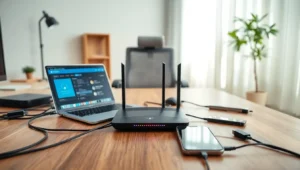In a world where cash is becoming as rare as a friendly smile from a tech support agent, P2P payment apps have swooped in to save the day. How often have you found yourself splitting the bill at dinner and fumbling with cash? Enter P2P payment apps, your new best friends in effortlessly transferring money at the tap of a finger. Imagine not having to brave the ATM at odd hours ever again and avoiding awkward IOUs in the group chat. This guide dives deep into everything you need to know about P2P payment apps, from how they work to the pros and cons. Let’s unravel this digital marvel with humor and insight, shall we?
Table of Contents
ToggleUnderstanding P2P Payment Apps

P2P payment apps, or peer-to-peer payment apps, help the easy transfer of funds between individuals. Typically, these services allow users to send and receive money directly using their smartphones, making transactions as simple as sending a text.
Gone are the days of shuffling for loose change or waiting for checks to clear. Many apps offer an intuitive interface, allowing even Grandma to send cash without accidentally sending a cat meme instead. Popular examples include Venmo, PayPal, Cash App, and Zelle, each bringing unique features and functionalities to the virtual table.
The rise of P2P payment apps can largely be attributed to the growing trend of a cashless society. In the U.S. alone, the number of mobile payment users has skyrocketed, simplifying the way people manage their finances by minimizing reliance on physical currency.
How P2P Payment Apps Work
Getting started with P2P payment apps is usually a walk in the park. Users must download their chosen app, create an account, and link their bank account or credit card. Once set up, sending money is as simple as typing in a recipient’s username, phone number, or email address, and hitting send. Voilà. Money transferred faster than you can say “instant gratification”.
Under the hood, these apps use a network of encryption and secure servers, which ensure your financial data remains locked up like a secret vault. Most apps leverage bank-level security, so there’s little to worry about when sending those crucial funds to your buddy for that overpriced latte. But, users should still be cautious and always verify transactions to avoid any mishaps.
Popular P2P Payment Apps Reviewed
When it comes to choosing the right P2P payment app, potential users have plenty of options. Here’s a brief overview of some of the most popular apps:
Venmo
Venmo is like the social media of money transfer. It allows users to share transaction details with friends, turning payments into social interactions. Although it may seem fun, people must be cautious about sharing sensitive information publicly.
Cash App
Cash App goes beyond mere money transfers by offering features such as a customizable debit card, direct deposit, and even stock trading. Users appreciate its simplicity and the potential for cashback rewards on purchases.
Zelle
Zelle is perfect for those who need instant transfer capabilities. Given that it’s integrated into many bank apps, users have the luxury of quick transfers directly from their existing banking environment, almost like magic.
PayPal
PayPal has been a longstanding giant in the digital payment space. Not only does it support P2P transactions, but it’s also recognized for online purchases. Also, it offers buyer protection, making it an appealing option for e-commerce enthusiasts.
Security and Privacy Considerations
While P2P payment apps offer unprecedented convenience, that doesn’t mean they come without risks. Security should always be top of mind. Many P2P platforms use advanced encryption methods, two-factor authentication, and transaction alerts to safeguard users’ data.
But, users should take their own precautions. Sharing personal information, even in a trusted network, can lead to potential fraud. Also, users should avoid using public Wi-Fi networks when making transactions, as these are often prime hunting grounds for cybercriminals.
Privacy settings vary between apps, so it’s essential to review app settings and restrict exposure where possible. After all, no one wants their latest pizza night transaction splashed across the public feed.
Advantages of Using P2P Payment Apps
The appeal of P2P payment apps lies in their myriad advantages. First off, they offer tremendous convenience. Forget about the hassle of cash: sending money can now be as simple as a few taps on the screen.
Also, P2P apps are often instant. Unlike traditional banking methods, which might take a few days, transactions between users typically occur within seconds or minutes. This quick turnaround can be invaluable for splitting bills or paying back friends.
Another shining feature is expense tracking. Many apps keep a record of transactions, allowing users to manage their finances better. With capable budgeting tools, users can easily keep track of who owes them money and how much.
Challenges and Limitations
Even though their benefits, P2P payment apps aren’t without their limitations. One notable drawback is transaction fees. Depending on the app and payment method, fees can eat into the amount being transferred, especially for credit card payments.
Also, not everyone uses the same app. This fragmentation can complicate transactions between individuals who prefer different platforms. Someone might find themselves having to create multiple accounts just to help a seamless currency exchange.
Finally, although they prioritize security, tech-savvy criminals are always probing for loopholes. Users must remain vigilant, keeping their apps updated and adopting good security practices.
The Future of P2P Payment Apps
Looking ahead, P2P payment apps are poised for considerable growth and innovation. With advancements in technology, users can expect improved security features and even greater functionalities. Integration with emerging technologies like blockchain may also usher in faster and more secure transactions.
Also, the burgeoning trend of digital currencies could see P2P apps adapting to accommodate cryptocurrency transactions. This potential shift might attract a younger audience eager to explore decentralized finance.
As digital wallets gain popularity, P2P payment apps will likely evolve to enhance user experiences, providing faster, safer, and more efficient ways to manage transactions.





